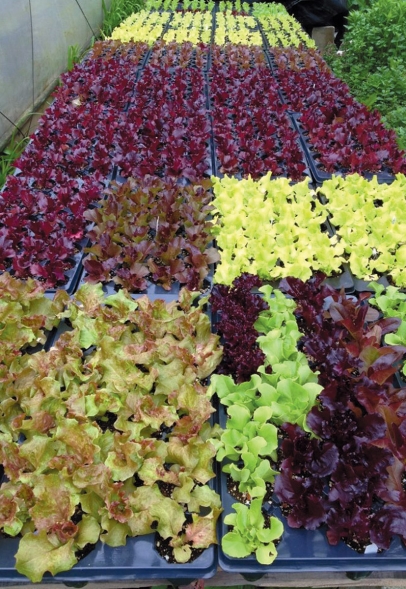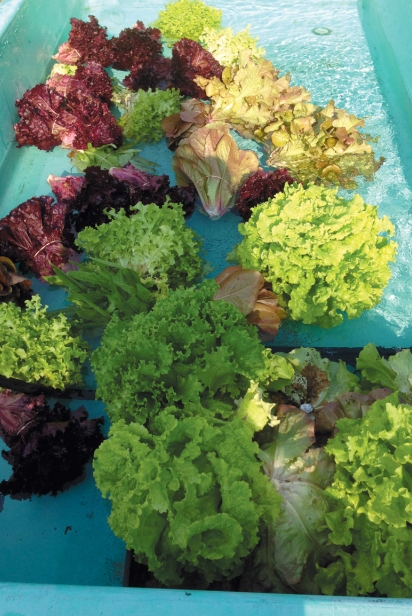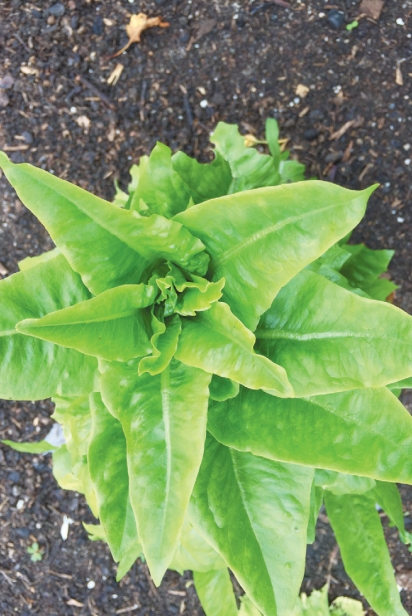Lettuce Alone
With a good 20 years of growing and selling lettuce for market under my belt, I’ve developed a bias for some particular varieties. I stumbled into my passion for growing lettuce quite accidentally while watching a Martha Stewart gardening show on TV. She was making a giant, multi-colored and textured checkerboard garden out of heirloom lettuces. She had trays upon trays lined up of lettuce of every color, size and texture. Until then I had no idea that there were so many types of lettuce. It was so fantastic and inspiring to see her mature checkerboard garden bed that I had to make my own.
I began searching out seed of the most interesting lettuces from around the world—both heirloom and modern—red, green, tinted brown, lime, frilly, pointy, headed, loose leaf and romaine. The more I searched the more I found, counting into the hundreds.
The local library asked me to give a presentation on heirloom herbs and vegetables that spring at my farm, so I took this opportunity to lay out my checkerboard lettuce garden, timing the planting to be at its perfection during the event. With an elevated platform for viewing from above, the attendees were delighted. Then, with lettuce knives and baskets in hand, we proceeded to cut the lettuces, making salads in huge antique wooden bread troughs. Some of the lettuces were so beautiful we didn’t have the heart to cut them up, so added them whole to the bowls surrounded by other chopped leaves and herbs. After the program, so many people interested in learning more about the varieties and their cultivation began contacting me, that it started me on my lettuce journey, ultimately bestowing me with my market nickname “the lettuce queen”.
As lettuce was cultivated from a weedy, bitter, prickly plant of ancient origin into the succulent salad delicacy of today (believed to have evolved from a weedy form that was used in ancient Egypt as a source of cooking oil from pressed seeds, as long ago as 2500 B.C.E.) it took many forms.
The original oilseed lettuce is a primitive, wild-looking plant that forms no head or rosette of leaves. It bolts early in its growth cycle, forming a thin stem with elongated, narrow leaves. The seeds produced on this stem are about twice the size of those formed on cultivated lettuce. The seeds were pressed to express an oil used in cooking. This is an ancient custom still practiced in Egypt today.
Lettuce that traveled to the western world evolved into a plethora of sizes, shapes and colors, while the lettuce that traveled east resembled somewhat of a romaine type which was the type used for its stem instead of its leaves. Stem lettuce is consumed raw in Egypt, or as a cooked vegetable in China called Celtic. Stem lettuce is grown mainly for the tasty stalk with celery-like flavor. Leaves are broad, oval-shaped and mid-green in color. Stems are thick, tender and crisp with white flesh. At the top of the stem emerges elongated leaves that eventually turn bluish green in color. The blue color in all lettuce is associated with the process of bolting or stem and seed formation. As the process of bolting begins, the leaves become bluish green, signaling the elongation of the stem, which emerges from the interior of the head. This is an early maturing variety, has good cold tolerance and can grow very large if allowed. Make sure to peel it, if you try it, as the core of the stem is the tasty part. This variety of lettuce may have been the one that first was eaten on the road to lettuce domestication.
Romaine lettuce was most likely the next improved, edible lettuce directly cultivated from these oilseed and stem lettuces. It is also known as Cos lettuce, allegedly because it was brought from the Aegean island of that name. Its journey continued to France, when the pope moved from Rome to Avignon in the 14th century, bringing it and its new name, romaine.
During my 20 years of trying to keep a constant supply of lettuce for the market, and growing over 40 varieties on a rotating, seasonal basis, with 3000 in ground at all times during the season, I have narrowed down my favorites to a very short list. They were not chosen for having all the qualities needed to grow successfully year round but rather because each has a moment in time when no other lettuce can surpass them in their own unique, culinary perfection. Through the years customers have constantly asked me what does this lettuce or that lettuce taste like. I always answer that lettuce is lettuce, it tastes like lettuce, it’s the texture they are searching for, although I must admit that there are a very few varieties that can actually develop a sweetness just before running to seed. Some say that a particular lettuce is bitter and I answer that it’s only bitter because it’s been standing to long, and picked too late and was in the process of bolting.
For lettuce to reach perfection it must grow quickly, uninterrupted by drought, nutrition and excess heat. Its window of harvest is very short, a day or two, and must be cut immediately and consumed shortly after. It seems that a lettuce’s lot in life is to set seed and it is in a race to reach that goal. In fact I have discovered that the closer the lettuce are planted to one another the faster they will bolt, as if they are vying for first place in the race for procreation. Turns out that most all but the tiniest heads should be allowed a square 12-inch spacing, just like Martha’s checkerboard squares!
When it comes to lettuce everyone has a personal favorite— romaine, looseleaf, iceberg or Boston—those types commonly sold in American supermarkets and offered up as nameless varieties. But you can venture beyond the basics and discover a whole new world in lettuce by seeking it out at local farmers’ markets or growing your own. Many of the best varieties, just like the tomato, will never be sold commercially as they are too tender for shipping or their window of harvest is too short. Along my lettuce journey I have found some extremely unique and delicious varieties. Here are my top lettuces to seek out. They are all an experience in culinary delight that took me decades to discover.
Deer Tongue lettuce by far is the most perfectly delicious lettuce I grow and goes beyond any lettuce lover’s expectations. It is #1 on my list. It meets the criteria of everything a lettuce must be. Crunchy, delicate, tender, it’s unsurpassable in the world of lettuce. It is quite small and sometimes described as having oily, soft, textured leaves, similar to a Butterhead or Buttercrunch lettuce. A distinctive lettuce, it looks much like a pinwheel growing in the garden and looks nothing like a lettuce, with its short, pointy leaves (resembling the shape of a deer’s tongue) wrapped tightly around its core and producing a blanched white base of crunchy, textured leaves. You will never see it in the grocery store and seldom in the market as it is so delicate that it could never make the trip. It melts like butter in your mouth. With this lettuce you don’t need anything else in your salad; forget the tomatoes, onions and cukes, just a press of garlic, salt and the lightest drizzle of olive oil! It is one of those things to look forward to in early summer like the fleeting rhubarb or raspberries. It grows best in late spring and then it’s gone until the weather cools down when one last planting is sometimes possible but never as good as in spring. The first record of a distinct variety of lettuce labeled as deer tongue lettuce in the United States appears in 1883. It is thought that this variety was brought to North America by English settlers around 1740 and was officially documented by the New York Agricultural Experiment Station in 1885. It seems that the origin of deer tongue lettuce within the United States is closely tied to New England.
Crisp Mint is my second pick, a big, bold, old-fashioned romaine with ruffled, mint-like, textured, crunchy leaves, almost as broad as it is high (unlike the common slender, smooth-leaf varieties found in grocery stores). It is my favorite romaine and wins hands down over all others with its bold texture and its ability to stay crisp in oil. Its only downfall might be that by mid-July it gives in to the summer heat, which is no different from any other romaine. They hate the heat. This romaine stands apart from all others and is a great choice for winter cold frames and high tunnels.
When the summer heat has melted all your lettuce to the ground, you know you have forgotten to plant my next two favorites: Batavian lettuce Loma and the old French heirloom iceberg Reine de Glace. Batavia lettuce is classed variously as a looseleaf lettuce or semiheading lettuce. In hot weather, the lettuce is slow to bolt, and its leaves retain their crispness even in hot growing conditions. Do remember, though, that successive plantings must be sown continuously all summer to keep a steady supply of lettuce coming, and the longer maturity time of a variety, the better it will hold up in heat. Most lettuces mature in 40 days or less but some take up to 90 days and these are the ones that I have found do best during the heat of the summer. They still may distort in shape somewhat, but they don’t go bitter. Also, the younger the lettuce, the more successfully it tends to ride it out during the onslaught of extended heat.
One July, during a weeklong heat wave, an entire planting of some 400, almost mature, lettuce (variety Loma, a Bavarian type) began to distort into hard headed, crumpled up mutants in the field before I could get them to market. The variety was somewhat of a tightly-wrapped, crunchy looseleaf normally, but with the prolonged 93- degree temperature began to put on heads like an iceberg lettuce but hard as a rock. A total loss, we thought, and we set out into the field to cut them all and feed them to the cattle at the farm, replacing them with flats of young lettuce starts. In the blazing heat and humidity we filled wheelbarrow after wheelbarrow and headed to the cow pen. Each lettuce must have weighed three pounds, incredibly compact and heavy. Jokingly someone took a bite of one and to our surprise it was as sweet a lettuce as anyone had ever tasted! Yes, sweet like sugar! We couldn’t believe it and stood there with hundreds of cut lettuce looking at each other in shock. Now what? Throw them away? Hundreds of dollars worth of lettuce piled in wheelbarrows? So we decided to chill them down, load them into the back of the truck and rush them over to a local supermarket. Since that time Loma lettuce has been my standard lettuce for summer heat. Nothing beats it in hot or cold weather. Any time of year is the right time to plant it. It is a sturdy, super crunchy, mid-green, medium sized, iceberg-looking lettuce that is never bitter.
Reine de Glace lettuce is very similar to Loma in its ability to survive heat as well as the cold. It is a big, beautiful heirloom iceberg with frilly outer leaves and a huge tight head that sweetens with age. The outer, dark green, lacy leaves are so pretty that you can harvest the heads and leave the rest to be cut as leaf lettuce. Both Loma and Reine de Glace have great shelf life after storing, too, probably triple that of most lettuces.
Last but not least is a mouthful of crunch and frill called Goldrush. Its lime-green leaves are strikingly frilled, curly, and crinkled yet tender at the same time, with a crunchy mid-rib giving a unique, superabundance of textures to your eating experience. It’s a little of every lettuce in one. It is probably the prettiest and definitely the most unique lettuce in my garden with its vase-shaped shape resembling a flowing fountain spray of delicate leaves.
So make that special trip to your farmers’ market and search out a new salad adventure! Bon appetit!







